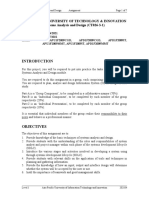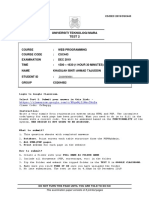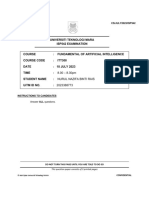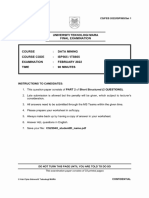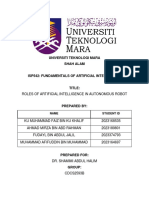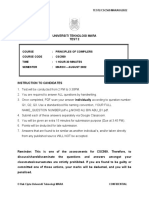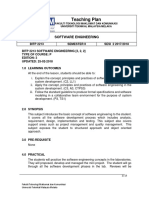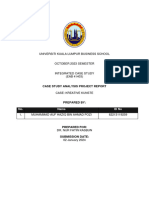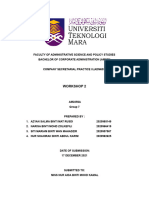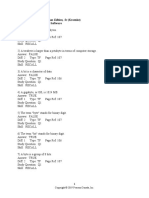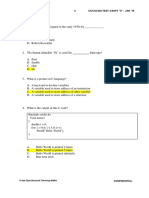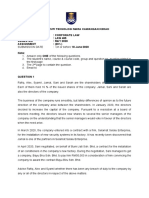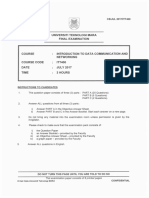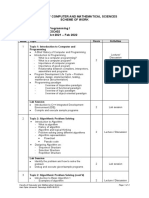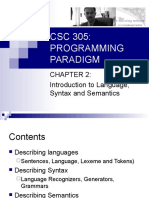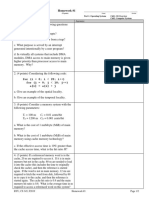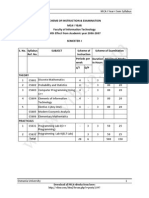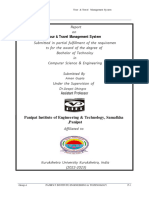FACULTY OF COMPUTER AND MATHEMATICAL SCIENCES
SCHEME OF WORK
Course
Course Code
Effective Of Date
Week
: Practical Approach of Operating System
: CSC204
: December 11 May 11
Topic
1.0
Activity
Basic OS Theory
1.1
1.2
Reference:
Textbook/Handout
Lecture/
Discussion
Understanding OS
1.1.1
What is OS?
1.1.2
OS and Computer System
1.1.3
History of OS
1.1.4
Types of OS
OS Functions and Components
1.2.1
Understanding OS
Components
1.2.1.1 User Command
Interface
1.2.1.2 Processor
Component
1.2.1.3 Memory
Component
1.2.1.4 Network
Management
1.2.1.5 I/O Component
1.2.1.6 File Component
1.2.1.7 Inter Process
Communication
(IPC)
1.2.2
Tutorial
OS Design Goals and
Influences
Further discussion
Faculty of Computer and Mathematical Sciences
@Hak Cipta Universiti Teknologi MARA
2009 Page 1 of 7
�FACULTY OF COMPUTER AND MATHEMATICAL SCIENCES
SCHEME OF WORK
1.3
OS Booting Concepts
1.3.1
Lecture /
Discussion
Understanding Booting
Process
1.3.1.1 DOS Booting
Sequence
1.3.1.2 Windows Booting
Sequence
1.3.1.3 Linux Booting
Sequence
1.3.2
Multiple OS Booting
Process
1.3.2.1 Windows Method
1.3.2.2 Non-Windows
Method
Tutorial
2.0
OS User View
2.1
Lecture /
Discussion
Understanding User Interface
2.1.1
Command-Line Interfaces
(CLI)
2.1.2
Graphical User Interfaces
(GUI)
2.1.3
CLI vs GUI
Tutorial
Exercise (Flowchart, Pseudo code)
4-5
2.2
File System
2.2.1
Understanding File
System/File Concept
2.2.2
Access Methods
Lecture /
Discussion
Programming Logic
and Design
Comprehensive,
Farrell, Joyce,
2.2.2.1 Sequential File
Faculty of Computer and Mathematical Sciences
@Hak Cipta Universiti Teknologi MARA
2009 Page 2 of 7
�FACULTY OF COMPUTER AND MATHEMATICAL SCIENCES
SCHEME OF WORK
2.2.2.2 Direct Access File
2.2.3
Directory Structure
2.2.4
File System Mounting
2.2.5
File Sharing
2.2.6
File Protection
Tutorial
Exercise (Simple algorithm design)
2.3
Device Driver
2.3.1
Understanding Device
Manager
2.3.2
Device Driver Interface
2.3.3
Device Driver API
2.3.4
Driver-Kernel Interface
Lecture /
Discussion
Question for
assignment
02
Programming Logic
and Design
Comprehensive,
Farrell, Joyce,
QUIZ 2
Tutorial
Exercise(Problem solving using logical operators only
without selection control structure)
7-8
3.0
OS System View
3.1
OS Performance Issues
3.1.1 Process Management
3.1.1.1 Single-Tasking
3.1.1.1.1
Seque
ntial
Proces
sing
3.1.1.1.2
Batch
Proces
sing
3.1.1.2 Multitasking
3.1.1.2.1
Multipr
ogram
ming
3.1.1.2.2
Time
Sharin
g
Syste
ms
3.1.1.2.2.1
Cooperativ
Lecture /
Discussion
TEST 1
(Up to Topic
5, Control
Structure,
Selection)
Programming Logic
and Design
Comprehensive,
Farrell, Joyce,
3.1.1.2.2.2
Pre-
Faculty of Computer and Mathematical Sciences
@Hak Cipta Universiti Teknologi MARA
2009 Page 3 of 7
�FACULTY OF COMPUTER AND MATHEMATICAL SCIENCES
SCHEME OF WORK
3.1.1.2.2.3
Context
3.2
3.1.1.3 Single-Tasking vs
Multitasking
3.1.2 Memory Management
3.1.2.1 Physical Memory
3.1.2.2 Virtual Memory
3.1.2.2.1
Page
Fault
3.1.2.2.2
Trashi
ng
3.1.2.2.3
Princip
le of
Localit
y
3.1.2.3 Virtual Memory
Requirements
3.1.3 I/O Management
3.1.3.1 I/O System
Organization
3.1.3.2 Direct I/O and
Memory Mapped
I/O
3.1.3.2.1
Direct
I/O
with
Polling
3.1.3.2.2
Interru
pt
Driven
Direct
I/O
3.1.3.3 Direct Memory
Access
3.1.3.4 Buffering
OS Protection and Security
3.2.1 Understanding OS
Protection and Security
3.2.2 Protection
3.2.3 Intruders
3.2.4 Malicious Software
3.2.5 Trusted Systems
3.2.6 Protection and Security
Design Principles
Tutorial
Exercise (Apply types of selection based on the given
problems)
MID TERM BREAK
Topic 5:
Faculty of Computer and Mathematical Sciences
@Hak Cipta Universiti Teknologi MARA
2009 Page 4 of 7
�FACULTY OF COMPUTER AND MATHEMATICAL SCIENCES
SCHEME OF WORK
8
Control Structure (Continued)
Iteration (Loops)
While and for statements
Simple iterations
Nested iterations
Lecture /
Discussion
Programming Logic
and Design
Comprehensive,
Farrell, Joyce,
Tutorial
Exercise & further discussions on iteration structure
9
Topic 6:
Algorithm Development (Continued)
Module
Introduction to Module
Modular Concept
Lecture /
Discussion
Question for
assignment
04
Problem Solving &
Programming
Concepts, Maureen
Sprankle, Jim
Hubbard
(Pg. 64)
Tutorial
Exercise (Apply modular design to solve problem)
10
Topic 6:
Algorithm Development (Continued)
Module (Continued)
Modular Design
Parameter passing
Lecture /
Discussion
QUIZ 4
Problem Solving &
Programming
Concepts, Maureen
Sprankle, Jim
Hubbard
Tutorial
Apply sorting and Searching problem
11
Topic 6:
Algorithm Development
Approach
Top down design
Bottom up design
Stub
Stepwise refinement
Lecture /
Discussion
QUIZ 3
Question for
assignment
03
C++ Problem Solving
with C++, Savitch,
Walter,
(Pg. 180 181)
Tutorial
Exercise (Stub, stepwise refinement)
Application of top down and bottom up approach in real
world problem
12
Topic 6:
Algorithm Development (Continued)
Module
Introduction to Module
Modular Concept
Modular Design
Parameter passing
Lecture /
Discussion
Question for
assignment
04
Problem Solving &
Programming
Concepts, Maureen
Sprankle, Jim
Hubbard
QUIZ 4
Tutorial
Apply sorting and Searching problem
Exercise (Apply modular design to solve problem)
13
Topic 7:
Introduction to List
Properties of list
Faculty of Computer and Mathematical Sciences
@Hak Cipta Universiti Teknologi MARA
Problem Solving &
Programming
2009 Page 5 of 7
�FACULTY OF COMPUTER AND MATHEMATICAL SCIENCES
SCHEME OF WORK
Concepts, Maureen
Sprankle, Jim
Hubbard
Index
Data type
Contiguous
(Pg. 249)
Tutorial
Exercise (suitable problems that involve array)
14
Topic 7
Introduction to List (Continued)
Operations using list
Minimum, Maximum, Count,
Average, Summation
TEST 2
Problem Solving &
Programming
Concepts, Maureen
Sprankle, Jim
Hubbard
Tutorial
Exercise (Minimum, Maximum, Count, Average,
Summation)
Assessment:
Final Examination
Course Work :
Test(2)
50%
50%
20%
Assignments(4-5)
10%
Quizzes
10%
Paired mini project
10%
Recommended Text
Farrell, Joyce, Programming Logic and Design
Comprehensive, Fifth Edition, Course Technology 2008.
References
1. Maureen Sprankle, Jim Hubbard, Problem Solving &
Programming Concepts, Eight Edition, Pearson
International Edition, 2009
2.
Nordin Abu Bakar, Suhana Sulong, Wan Dorishah
Wan Abd. Manan, Asas Pembentukan Algoritma,
Ummah Media Sdn. Bhd.
3. David Harel, Algorithmic, the spirit of computing, 2nd
Edition, Addison Wesley, 1992
4.
Haag, Stephen, Computing Concepts, Complete
Edition, McGraw Hill, 2002.
5.
Zak, Dianne, An Introduction to Programming with C+
+, 2nd edition, Course Technology, 2001.
6.
Robertson, Lesley, Simple Programming Design, 3rd
edition, Course Technology, 2000.
7.
Uckan, Yuksel, Problem Solving Using C, 2nd edition,
McGraw Hill, 1999.
Faculty of Computer and Mathematical Sciences
@Hak Cipta Universiti Teknologi MARA
2009 Page 6 of 7
�FACULTY OF COMPUTER AND MATHEMATICAL SCIENCES
SCHEME OF WORK
8.
Kenneth A. Lambert, Nance, Understanding
programming and Problem Solving with C++, West
Publishing, 1996.
9.
Malik, D.S., C++ Programming: From Problem
Analysis To Program Design, Course Technology,
2002.
10. Savitch, Walter, C++ Problem Solving with C++, Sixth
Edition, Pearson International Edition, 2006
Approved by
-------------------------Pengerusi Pusat Pengajian Sains Komputer
Faculty of Computer and Mathematical Sciences
@Hak Cipta Universiti Teknologi MARA
2009 Page 7 of 7
